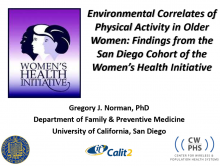We are pleased to announce an exciting new alliance between Active Living Research and GP RED to co-host and coordinate...
Environmental Correlates of Physical Activity in Older Women: Findings from the San Diego Cohort of the Women's Health

Presentation at the 2011 Active Living Research Annual Conference
Background:
The percentage of older adults in the US is increasing resulting in increasing health care costs. Physical activity (PA) has beneficial health effects but older adults are the least active age-group, with less than 3% meeting PA recommendations. Older adults’ PA may be more susceptible to the neighborhood environment, particularly as functional status becomes more limited. To design WHO designated age friendly cities, it is important to understand environmental factors specific to seniors.
Objectives:
In a sample of older adult women, the current study used geographic information systems (GIS) to determine built and physical environment exposures as correlates of PA.
Methods:
Participants were from the San Diego cohort of the Women’s Health Initiative (WHI), a large multi-center study of the predictors of morbidity and mortality among post-menopausal women. Approximately 5,626 women were enrolled between 1993 and 1998. A total of 5,401 (96.0%) women had valid residential addresses that were geo-coded to create 0.5, 1, and 3-mile street network buffers around each resident’s home address. Spatially linked environment data sources (e.g., types of land uses, and location of neighborhood parks) determined environmental exposures near the participant’s residence using ArcGIS 9.1 software.
Three physical activity estimates were calculated from baseline WHI survey questionnaires. Total walking was calculated as MET hours/week for all walking intensities. Moderate to vigorous physical activity (MVPA) was calculated as MET/hrs/wk of strenuous and moderate activity. Total activity was the sum of MET/hrs/wk of activities greater than 3 METs.
Linear regression models were specified for the log transformed PA outcomes (total walking, MVPA, total activity) for each network buffer (.5, 1, 3 miles). Independent variables included demographic covariates (age, education, ethnicity, and family income), perceived general health, the walkability index, school density, recreation facility density, distance to the coast, and distance to the nearest park.
Results:
The mean age was 64 years old (SD = 7.65), 75% identified as White-Non-Hispanic and 36% reported annual household incomes greater than $50k. The majority of the sample was married (58%) and had an education greater than 12th grade (68%). Most women (88%) perceived their general health to be good to excellent. The median for hours/wk of walking was 1.25 with 15% of women reporting no walking. The median hours/wk of MVPA was 0.33 with 45.8% of women reporting no MVPA. The median for total activity was 2.75 hours/wk.
For total walking, the walkability index was related to walking in the .5 mile buffer (Beta = .049, p = .004) but not in the 1 or the 3 mile buffers. Higher school density was consistently related to less walking in all three buffers (Betas = -.043 to -.061). Recreational facilities density was related to walking in the 1 mile buffer (Betas = -.067, p = .001). Living closer to the coast was related to more walking (Betas = -.061 to -.068). The regression models accounted for 2.3% of the variance in walking. For MVPA, only school density in the 3 mile buffer (Beta = -.062, p < .001) and recreation facilities density in the 1 mile buffer (Beta = .039, p = .008) were significant correlates. The models accounted for about 4% of the variance in MVPA. Total activity was inversely related to school density in the 1 and 3 mile buffers (Beta = -.035, p = .019; Beta = -.083, p < .001, respectively). Recreation facilities density was associated with higher levels of total activity in the 1 and 3 mile buffers (Beta = .062, p <.001; Betas = .031, p = .050). Living closer to the coast was related to higher levels of total activity (Betas = -.035 to -.043). The regression models accounted for about 5% of the variance in total activity.
Conclusions:
The findings suggest that for women between 50 and 79 years, walking may be influenced by their neighborhood environment. The density of recreational facilities in a neighborhood was related to activity outcomes only in the 1-mile buffer, suggesting that women were more likely to be more active (walking and more strenuous activities) when more recreation facilities were within a short driving distance from their residence. Inverse relationships between neighborhood school density and PA indicated that schools were not perceived as facilities for PA and in fact may serve as a barrier to activity for older adults. Distance from residence to the coast was related to walking and total activity but not MVPA, suggesting that San Diego’s many beaches provide safe and attractive places for seniors to walk. Study limitations included use of GIS data sources that were temporally disparate from WHI data collection, and self-report measures of PA. Study strengths included the large sample of women and the use of GIS to create environmental variables.
Support:
This work was supported by a grant from the National Cancer Institute R21CA127777.
STAY UP TO DATE
RECENTLY ADDED TOOLS & RESOURCES
MOVE! A BLOG ABOUT ACTIVE LIVING
The "Active Living Conference" aims to break down research and practice silos and...







